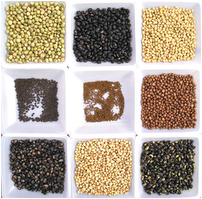Handouts & Information
For additional and new articles please visit my BLOG
Seed Cycling for Natural Hormonal Balance
Rotating of seeds is a valuable way of restoring hormonal balance for men and women. Seed cycling is so effective because the hulls of the seeds contain chemicals called lignans, which help modulate the hormonal pathways of the body while the seed oils are comprised of essential (or omega) fatty acids that provide the building blocks for steroid hormone synthesis.
As each seed type contains variations of these lignans and fatty acids, rotation of these seeds through the month provides the body with the variety of precursors it needs to create normal hormonal cycles. The additional oils (EPA/DHA & GLA) may also be added for added balancing.
Women:
The rotation plan can be done according to either the menstrual cycle (if it is fairly regular) or phases of the moon (if the menstrual cycle is absent or too irregular)
* From days 1-14 of the menstrual cycle (or from new moon to full moon)
1-2 Tablespoon(s) per day of ground flax/ pumpkin seeds/ or Chia Seeds
EPA/DHA 2,000 – 3,000 mg EPA/DHA (1,500 each)
Flax and pumpkin seeds support the ESTROGEN dominant time of your cycle and balancing the omega 3 pathway.
* From days 15 – 28 of the menstrual cycle (or from full moon to new moon)
1-2 Tablespoon(s) per day of ground sesame or sunflower seeds.
GLA (Borage or Evening Primrose Oil) 500 mg
GLA (rich in Omega 6s that contains linoleic acid) converts in the body ultimately to prostaglandins, hormone-like molecules that help regulate Inflammation and blood pressure as well as heart, gastrointestinal, and kidney functionsSesame and sunflower seeds support the PROGESTERONE peaks of your cycle and balancing the omega 6 pathway.
Men: The rotation plan is done according to the phases of the moon (and is the opposite of women’s rotation):
* From full moon to the new moon: 1-2 Tablespoon per day of ground flax or pumpkin seeds.
* From new moon to the full moon: 1-2 Tablespoon per day of ground sesame or sunflower seeds.
Seed Preparation: It works best to use a coffee or spice grinder to grind the seeds. Only prepare a few days supply at a time as the seeds may oxidize and become less potent. Store the ground seeds in a jar with a tight fitting lid and keep in the refrigerator. One or two tablespoons per day can be used. You can eat the seeds with any foods such as salads, cereals, vegetables, grains or mix them in a little rice or soymilk and drink them. It adds a nutty crunchy taste to foods. IT IS BEST TO USE ORGANIC AND RAW SEEDS.
Seed Facts
Flax Seeds
Flax seeds are high in B vitamins, manganese and magnesium. These power-packed seeds have many other nutrition components. 100 grams of ground flax seed supplies about 450 kilocalories, 28 grams/fiber and 20 grams/protein. Flax seeds should be ALWAYS be ground fresh before consumption (reduces rancidity) and can be added to any meal.
Pumpkin Seeds
Pumpkin seeds are very beneficial to your health because of the minerals they provide. The seeds contain high amounts of iron, magnesium phosphorus and zinc. They are also a fantastic source of protein (2 grams per tablespoon), phytosterols and beneficial polyunsaturated fats.
Sesame Seeds
Sesame seeds are very rich in iron, magnesium, manganese and copper. There are about 90 mg of calcium in one tablespoon of unhulled seeds and 10 mg in hulled seeds. They also contain vitamin E (tocopherol) and vitamin B1 (thiamine). Sesame seeds contain the richest source of lignans, namely sesamin (a phytoestrogen), which has antioxidant and anti-cancer properties. The phytosterols present in sesame seeds are associated with reduced levels of blood cholesterol.
Sunflower Seeds
Sunflower Seeds are a rich source of vitamin E; also contain linoleic acid (an essential fatty acid), amino acids and minerals that include magnesium, potassium, zinc and calcium. Sunflower seeds are rich in phytosterols and can be part of a cholesterol-lowering diet. The nutritional value in one serving (1/4 cup) includes, 3.0 g/fiber and 6.0 g/protein. A serving of raw sunflower seeds also provides a person’s daily requirement of iron (about 13%).
As each seed type contains variations of these lignans and fatty acids, rotation of these seeds through the month provides the body with the variety of precursors it needs to create normal hormonal cycles. The additional oils (EPA/DHA & GLA) may also be added for added balancing.
Women:
The rotation plan can be done according to either the menstrual cycle (if it is fairly regular) or phases of the moon (if the menstrual cycle is absent or too irregular)
* From days 1-14 of the menstrual cycle (or from new moon to full moon)
1-2 Tablespoon(s) per day of ground flax/ pumpkin seeds/ or Chia Seeds
EPA/DHA 2,000 – 3,000 mg EPA/DHA (1,500 each)
Flax and pumpkin seeds support the ESTROGEN dominant time of your cycle and balancing the omega 3 pathway.
* From days 15 – 28 of the menstrual cycle (or from full moon to new moon)
1-2 Tablespoon(s) per day of ground sesame or sunflower seeds.
GLA (Borage or Evening Primrose Oil) 500 mg
GLA (rich in Omega 6s that contains linoleic acid) converts in the body ultimately to prostaglandins, hormone-like molecules that help regulate Inflammation and blood pressure as well as heart, gastrointestinal, and kidney functionsSesame and sunflower seeds support the PROGESTERONE peaks of your cycle and balancing the omega 6 pathway.
Men: The rotation plan is done according to the phases of the moon (and is the opposite of women’s rotation):
* From full moon to the new moon: 1-2 Tablespoon per day of ground flax or pumpkin seeds.
* From new moon to the full moon: 1-2 Tablespoon per day of ground sesame or sunflower seeds.
Seed Preparation: It works best to use a coffee or spice grinder to grind the seeds. Only prepare a few days supply at a time as the seeds may oxidize and become less potent. Store the ground seeds in a jar with a tight fitting lid and keep in the refrigerator. One or two tablespoons per day can be used. You can eat the seeds with any foods such as salads, cereals, vegetables, grains or mix them in a little rice or soymilk and drink them. It adds a nutty crunchy taste to foods. IT IS BEST TO USE ORGANIC AND RAW SEEDS.
Seed Facts
Flax Seeds
Flax seeds are high in B vitamins, manganese and magnesium. These power-packed seeds have many other nutrition components. 100 grams of ground flax seed supplies about 450 kilocalories, 28 grams/fiber and 20 grams/protein. Flax seeds should be ALWAYS be ground fresh before consumption (reduces rancidity) and can be added to any meal.
Pumpkin Seeds
Pumpkin seeds are very beneficial to your health because of the minerals they provide. The seeds contain high amounts of iron, magnesium phosphorus and zinc. They are also a fantastic source of protein (2 grams per tablespoon), phytosterols and beneficial polyunsaturated fats.
Sesame Seeds
Sesame seeds are very rich in iron, magnesium, manganese and copper. There are about 90 mg of calcium in one tablespoon of unhulled seeds and 10 mg in hulled seeds. They also contain vitamin E (tocopherol) and vitamin B1 (thiamine). Sesame seeds contain the richest source of lignans, namely sesamin (a phytoestrogen), which has antioxidant and anti-cancer properties. The phytosterols present in sesame seeds are associated with reduced levels of blood cholesterol.
Sunflower Seeds
Sunflower Seeds are a rich source of vitamin E; also contain linoleic acid (an essential fatty acid), amino acids and minerals that include magnesium, potassium, zinc and calcium. Sunflower seeds are rich in phytosterols and can be part of a cholesterol-lowering diet. The nutritional value in one serving (1/4 cup) includes, 3.0 g/fiber and 6.0 g/protein. A serving of raw sunflower seeds also provides a person’s daily requirement of iron (about 13%).

Immune Boosting Soup
- Click the link to the right to download the recipe |
| ||||||
Home Hydrotherapy: Warming Sock Treatment to Boost Immunity

What is the warming sock treatment effective for?
The cold sock hydrotherapy treatment is an easy and effective treatment that can be used to relieve nasal and head congestion and to stimulate the immune system (specifically in the upper respiratory tract) while you sleep. This treatment is particularly effective in relieving symptoms of common colds and flu’s such as runny nose, sore throat, ear aches, head aches, and sinus infections.
What will you need?
1 pair of wool socks
1 pair of cotton socks
cold water
hot water or a heating pack
Procedure
1. Wet the wool socks under the cold tap water then ring them out so that they are not dripping.
2. Fill foot basin with hot water and soak feet for at least 10 minutes or until they are warm and pink. This step may be skipped if you are already warm or hot.
3. Dry off your feet and put the wet wool socks on followed by cotton socks over top.
4. Get into bed with both socks on, and overnight you should dry and warm them.
For best results, his treatment can be used on consecutive nights until symptoms subside.
Information for this pamphlet was taken from Lectures in Naturopathic Hydrotherapy. (1998) Boyle & Saine and class notes (Hydrotherapy, Dr.Mather)
The cold sock hydrotherapy treatment is an easy and effective treatment that can be used to relieve nasal and head congestion and to stimulate the immune system (specifically in the upper respiratory tract) while you sleep. This treatment is particularly effective in relieving symptoms of common colds and flu’s such as runny nose, sore throat, ear aches, head aches, and sinus infections.
What will you need?
1 pair of wool socks
1 pair of cotton socks
cold water
hot water or a heating pack
Procedure
1. Wet the wool socks under the cold tap water then ring them out so that they are not dripping.
2. Fill foot basin with hot water and soak feet for at least 10 minutes or until they are warm and pink. This step may be skipped if you are already warm or hot.
3. Dry off your feet and put the wet wool socks on followed by cotton socks over top.
4. Get into bed with both socks on, and overnight you should dry and warm them.
For best results, his treatment can be used on consecutive nights until symptoms subside.
Information for this pamphlet was taken from Lectures in Naturopathic Hydrotherapy. (1998) Boyle & Saine and class notes (Hydrotherapy, Dr.Mather)
